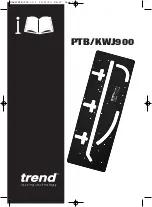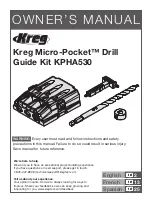
10
English
Using plunge cutting
WARNiNG:
To avoid loss of control, broken blades, or damage to the
material being cut, always use extreme caution when making plunge cuts. We do
not recommend plunge cutting on materials other than wood.
When using the plunge cutting method, a starting hole or lead in cut from the work piece edge is not
necessary. It is best to practice plunge cutting on scrap wood so the operator becomes familiar with the
technique.
1. Tilt the saw forward so that it rests on the front edge of the base with the blade point positioned just
above the work piece surface.
2. Make sure the blade is inside the area to be cut.
3. Apply downward pressure to the tool so that the front edge of the base will not move when you turn on
the tool.
4. Turn on the tool and gently lower the back end of the saw until the blade contacts the work surface.
5. As the blade pierces the workpiece, slowly lower the base of the tool down onto the workpiece surface
until it is in the normal cutting position.
6. Complete the cut in the normal manner.
SCROLL CUTTING
Scroll cuts can be made with the jig saw by guiding the direction of the cut with applied pressure on the
handle.
WARNiNG:
Excessive side pressure to the blade could result in broken
blades or damage to the material being cut.
Summary of Contents for MLJS12C
Page 44: ...44 NOTES...










































